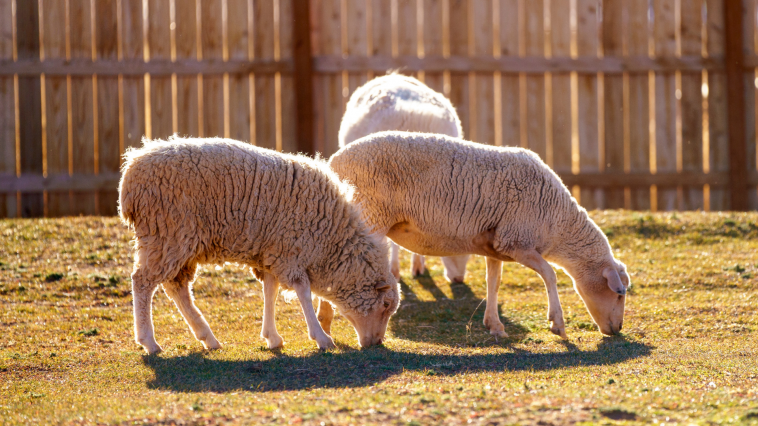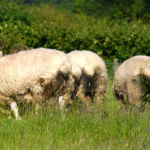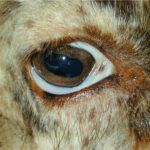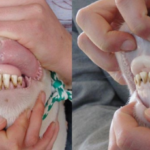Devastating losses can be caused in sheep flocks by parasites. In most sheep production areas, internal parasites, or gastro-intestinal nematodes, also known as worms, are the primary disease affecting sheep and lambs. Sheep are more vulnerable to internal parasites than most other types of farm livestock for several reasons. Their small faecal pellets disintegrate very easily thus releasing the worm larvae onto pastures.
Your animals
Good nutrition, especially protein and trace minerals, is essential to support immunity. Animals cannot express their genetic potential for parasite resistance and resilience if they are not adequately fed. The importance of dietary protein has been well established. Sickly or parasite infested animals become unproductive and give birth to weak offspring; they also struggle to feed their lambs.
For your animals to develop immunity to parasites, adequate exposure is needed to develop a strong immunity. The goal should not be to totally eradicate parasites, but rather to establish a balance between the host and parasites. At the same time, exposure should not be so great that it overcomes the natural ability of the animal to resist worms.
Parasites
Parasites commonly found in sheep can be divided into two general categories: external (skin) and internal (organ) parasites. Because internal parasites tend to prefer a specific organ, there are multiple types.
The most common internal parasites in sheep are:
Lung worms
Lung worms irritate the bronchioles inside the lung and cause a local reaction with mucus and white blood cells (phlegm) that are trying to get rid of the parasites. The irritation and pain cause the animal to cough.
Stomach worms
Stomach worms are voracious bloodsuckers and will destroy the lining of the stomach to access the bloodstream. The destruction of the lining of the stomach can cause colic (abdominal pain), diarrhoea, anaemia, and weight loss due to the animal’s inability to digest feed completely.
Liver flukes
Liver flukes burrow tunnels in the liver, causing scarring as the body tries to repair the damage. Because scar tissue is not functional, the liver loses part of its normal function, which includes filtering the blood of toxins and waste products. The accumulation of these toxins in the animal’s blood can severely damage other organs, including the brain. Therefore, a common sign of liver fluke infestation is depression or limpness.
Coccidia
Coccidia live in the lining of the intestines and destroy the crypts that the animals need to absorb nutrients. Therefore, the most common sign of coccidian infestation is diarrhoea (detected by dirty hind ends), and failure to thrive, or weight loss.
What are typical signs of parasitism?
- Weight loss: animals do not get all the nutrients they need.
- Diarrhoea: detected by the dirty tail and hind end (Figure 1).
- Rough hair coat: when nutrients are insufficient, the animal’s hair loses its lustre.
- Depression: animals keep their head and ears down and are not willing to stand for long periods of time.
- Weakness: animals are easier to catch or unstable when walking.
- Anaemia: the animal’s gums, perineum, and eyes appear white due to blood loss (Figure 2 and Figure 3).
- Fever or, in the late stages of the disease, cold extremities (for example ears and legs).
- Fast breathing (lung worms): animals try to get oxygen into their damaged lungs.
- Coughing (lung worms): animals cough from the irritation of their damaged lungs.
- Sheep with diarrhoea.
- Anaemia in sheep.
- Comparison of the gums of a normal sheep (left) and a sheep with severe anaemia (right).
Pastures
Since pasture is the vector for transmission, pasture factors must be considered when developing a parasite control program. Pastures with good drainage carry a lower risk of severe parasite infection as compared to poorly drained paddocks.
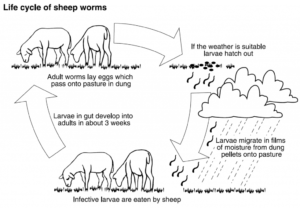
Monitoring
FAMACHA©
The FAMACHA© system was developed in South Africa due to the emergence of drug-resistant worms. The system uses an eye anaemia guide to evaluate the eye colour of a sheep (or goat) to determine the severity of parasite infection and the need for deworming.
Bright red colour indicates that the animal has few or no worms, or that the sheep can tolerate its worms. An almost white eyelid is a warning sign of bad anaemia; the worms present in the sheep’s gut are in such numbers they are draining the animal of blood. If left untreated, such an animal will soon die.
The FAMACHA© chart contains five eye scores (1 to 5), which have been correlated with packed cell volumes (percentage of blood made up of red blood cells, also called haematocrit). Animals in categories 1 or 2 (red or red, pink) do not require treatment, whereas animals in categories 4 and 5 (pink-white and white) do. Animals in category 3 may or may not require treatment depending upon other factors.
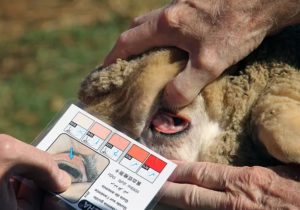
FAMACHA© System
| Clinical category |
Eye colour | Packed cell volume (PCV) |
Treatment guideline |
| 1 | Red | > 28 | No |
| 2 | Pinkish red | 23 – 27 | No |
| 3 | Pink | 18 – 22 | Maybe |
| 4 | Pinkish white | 13 – 17 | Yes |
| 5 | White | < 12 | Yes |
Mature sheep in category 3 (pink colour) probably do not require treatment, whereas lambs or other susceptible animals might require (or benefit from) treatment if they are in category 3. The frequency of examination depends upon the season and weather pattern, with more frequent examination usually necessary in July, August, and September, the peak worm season.
The FAMACHA© system results in fewer animals being treated, which slows down dosage resistance. It identifies worm-infested animals that require treatment. Persistently wormy animals, especially breeding rams, should be culled. The process of inspecting the eyes is quick and can be incorporated with other management practices. Proper handling facilities will facilitate the use of the FAMACHA system.
Treatment and prevention
It is important not to introduce resistant worms to the farm. Newly acquired animals should be properly quarantined and dewormed to prevent the introduction of resistant worms. You have to be sure to use the right deworming treatment for your specific situation.
The FAMACHA© system should be incorporated into an integrated worm control programme that includes other management practices, such as pasture rest, good nutrition, multi-species grazing, alternative forages, zero grazing, and genetic selection. FAMACHA© should only be used by professionally trained individuals. To obtain a FAMACHA© card, the farmer must follow an approved training course. It is now possible to receive online training.
The best prevention is to reduce your animal’s exposure to parasites is by providing a clean environment (beginning at birth) and avoiding overcrowding of pens or camps. Balanced nutrition is especially important to keep animals healthy and help them develop appropriate resistance to external pathogens, especially for dams before and after lambing. Remember a happy sheep is a productive sheep!
We thank the ARC Institute for Agricultural Engineering in South Africa who made their manual on sheep production and facilities available to the readers of ProagriMedia.

